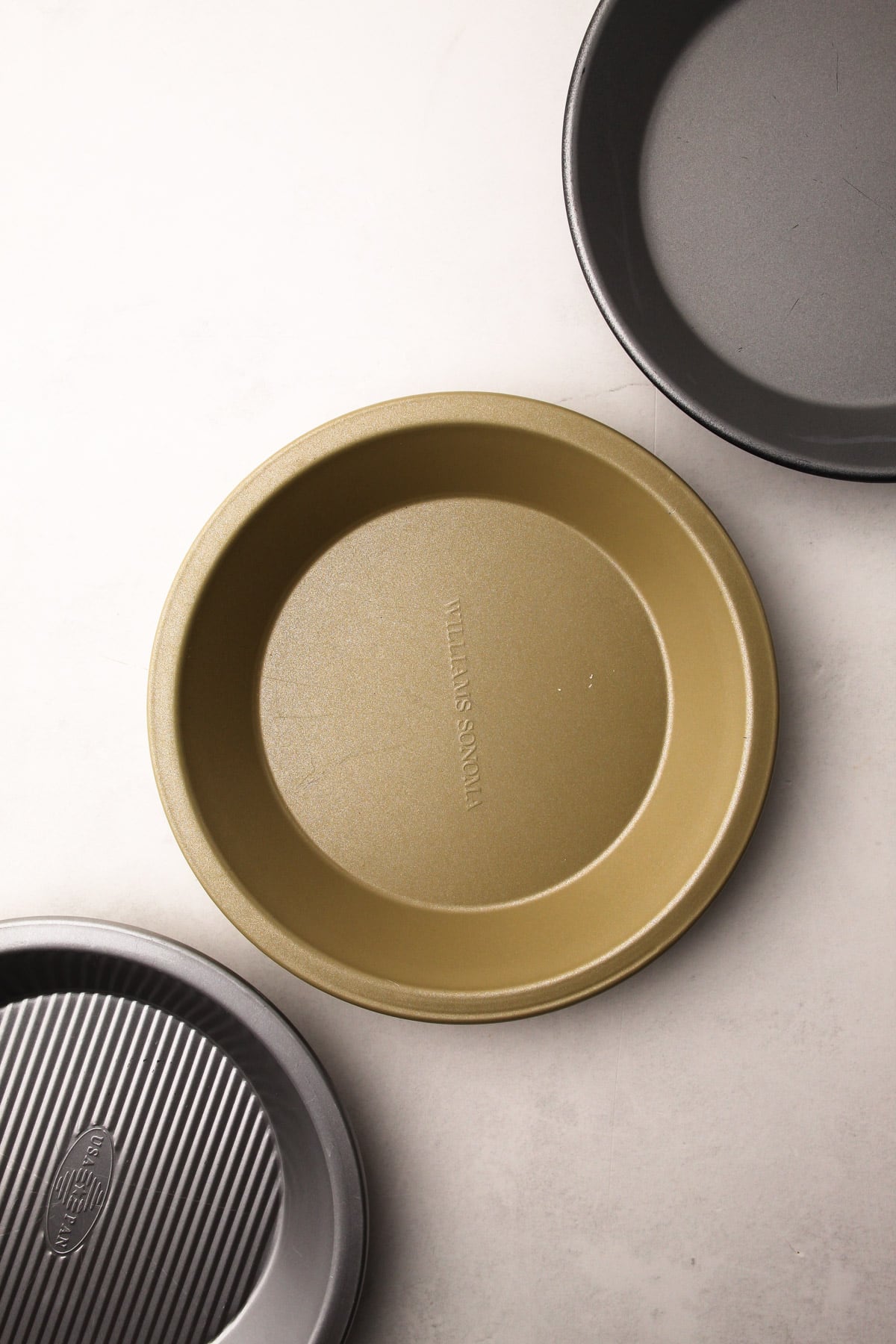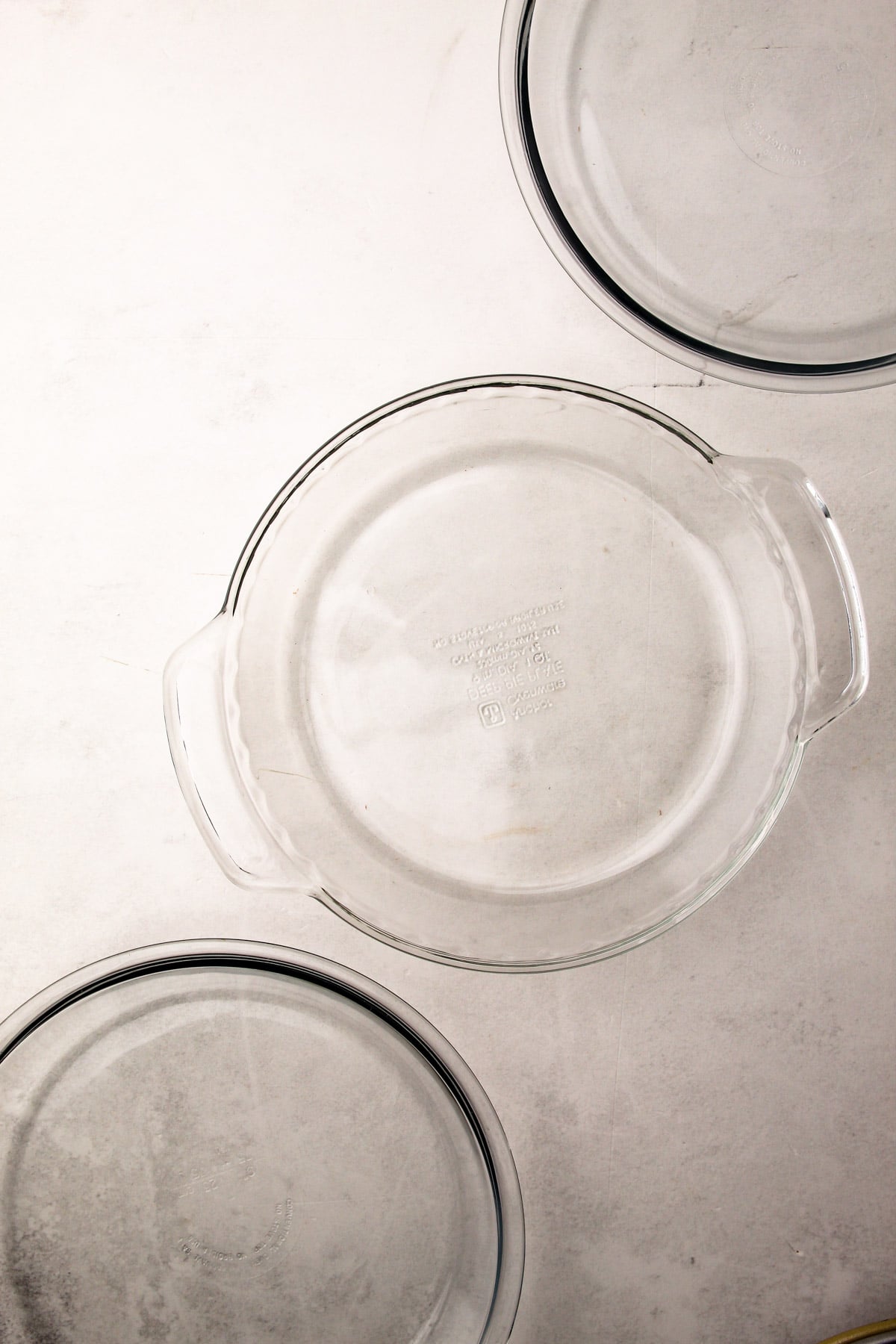When it comes to choosing the perfect pie dish, the options can seem overwhelming. This comprehensive Guide to the Best Pie Pans explores the pros and cons of all the various types, and shares the one pie pan all kitchens should have.

Want to save this recipe?
Enter your email & I'll send it to your inbox. Plus, get weekly updates from me!
As a professional pie baker with well over a decade of pie making experience, I am often asked the question: "What is your favorite pie pan?" And wow, do I have a lot of thoughts on that! The answer, though, is that it depends on the pie. Selecting the right pie pan involves several considerations.
While I'd argue it's possible to successfully bake a pie in any pie pan if you follow the recipe and best pie baking practices, choosing the "wrong" type of pie pan can make that task an uphill battle.
In this post, I'll dive deep into the nuances of various pie dish options, weighing their advantages and disadvantages.
Want to skip over the article and get my overall recommendation? Use the table of contents below and jump to "Overall Best Pie Pan."
Pie Plate Considerations
To some degree, choosing a pie plate comes down to personal preference. My own preference has changed over the years, as the quantity of pies I've baked has increased and I've seen the effects different pie pans have had on the final products. But here are the factors worth considering when it comes to choosing the best one for you:
Size
Pie pans can come in many different sizes and depths and still be considered a "typical" pie plate. Generally speaking, a "standard" size is 9 inches wide and 1-½ inches deep. I develop all of my recipes to this size. But they can be as small as 6 inches or as large as 12 inches wide. They also can be as much as 2-½ inches deep, or more. Why does that matter? Because the volume of your recipe might not match the pie pan, resulting in an under-filled or overfilled pie.
Versatility
Some pie pans are better (or not at all good) for different types of pie. Ideally, it should be versatile and work for all types of pie (and spoiler: that is precisely the reason I chose my number one pie plate pick).
Price
The price of a pie dish can range from a few dollars (or less) to a few hundred dollars for a handmade ceramic one! It's important to keep in mind that pies are often a portable dessert brought to picnics or parties, and bringing an expensive pie dish along with you isn't necessarily the wisest choice.
Appearance
We all know that we eat with our eyes as much as our taste buds, and seeing a beautifully crafted pie baked in a beautiful pie plate is a sight to behold. But how much this matters to you is largely a matter of personal preference.
Heat Conduction
Heat conduction is a critical factor when it comes to pie pans. It determines how the crust of your pie bakes and, ultimately, the quality of your finished pie.
Different materials have different properties of heat conduction. Good heat conduction in a pie plate means it heats up quickly and evenly and it holds that heat effectively. A pie dish with good heat conduction transfers its heat to the pie itself, ensuring the pie bakes evenly and develops a good crust, regardless of the type of pie you're preparing. Heat conduction is a key factor in achieving professional-level pie results.

Types of Pie Dishes
Pie plates come in various materials, each with unique characteristics and their own pros and cons. Aside from its size, you'll also need to choose the right pie dish material for the type of pie you want to make. While there are many materials that pie plates can be made out of, in this article, we will stick to the three most common: metal, glass, and stoneware.

Metal Pie Plates
Typically made of aluminum or stainless steel, metal pie plates are the best conductors of heat. They heat up quickly and maintain that heat well, which helps to achieve a crispy crust.
If you've ever had trouble with getting browning on the bottom of your pie crust, try baking it in a metal pie plate.
Many metal pie plates available for purchase have a nonstick coating as well. While this can be good for double-crust fruit pies, for other pies, such as those with a crumb crust, a non-stick coating can actually be detrimental. The slippery surface can cause the crumb crust (and even a butter pie crust in some cases) to slip down the sides. I specifically advise against using nonstick metal pie plates for any pie with a cookie crumb crust.
Additionally, the nonstick coating can be easily damaged and flake off. The easiest way to damage it is by cutting into a pie while it's still in the pan, which is a big disadvantage in my mind since cutting the pie directly in the pie plate is the easiest (and best) way to do it.
In terms of size, metal pie plates often come in the standard 9-inch diameter and 1-½-inch depth, which is ideal.
As for price, metal pie plates are typically moderately priced.
A cast-iron pie plate isn't as common to see, but it also belongs in this category. Since it is metal, cast iron conducts heat well, but is slightly slower to heat up than thinner traditional metal pie plates.
Metal Pie Dish TL:DR
- Pro: Most efficient conductor of heat
- Pro: Makes a super crispy crust
- Con: Nonstick surfaces can cause pie crusts to slip down
- Con: Nonstick coatings can be easily damaged when slicing into pies

Glass Pie Plates
Glass pie dishes are moderately efficient at heat conduction. When compared to metal, they take a bit longer to heat up and don't distribute the heat quite as evenly. But they still do a good job, especially if you're following the rules for baking a pie well.
A big pro is that they are see-through so that you can monitor the bottom of the pie for doneness. Just remember: a brown crust doesn't indicate that the filling is done, so don't use that as the only indicator that your pie is well-cooked.
The size of glass pie plates can vary. Some are larger or smaller than the standard 9-inch diameter size, and some are deeper than the standard 1-½-inch depth.
Glass pie plates are very inexpensive, making them a great option for baking gift pies to give away easily.
Glass Pie Dish TL:DR
- Pro: Can see through the pie dish to monitor baking
- Pro: The least expensive option
- Pro: Extremely versatile for all types of pie
- Con: Moderately effective conductor of heat

Stoneware Pie Plates
Stoneware pie dishes are made out of clay that is fired at a very high temperature. The most common type of stoneware is ceramic. Stoneware is the poorest conductor of heat out of this lineup of pie plates, as it heats up the most slowly. However, it does distribute heat evenly and maintains heat well once it is hot. Stoneware is a good choice for more delicate pies like pumpkin or custard. Just be aware your bottom crust may be in more danger of being soggy, especially with butter pie crusts.
Another issue with stoneware is that it is often oversized, leading to a pie that looks oddly under-filled if you make the crust go up over the edges. However, they can be considered a "deep dish" pie plate, so if your pie recipe calls for that, a large stoneware pie plate can be a good choice.
Ceramic pie plates are undoubtedly the most beautiful, adding to the appeal of a pie. However, that beauty certainly comes with a (literal) price because ceramic pie plates can often be quite expensive. They are also heavy.
Stoneware Pie Dish TL:DR
- Pro: They are beautiful
- Pro: They maintain heat well once hot, and work well for delicate pies
- Con: They are poor conductors of heat, so often lead to under-baked butter crusts
- Con: They are often oversized compared to a standard pie dish
- Con: They are expensive
Overall Best Pie Pan

Overall, a glass pie plate is the quintessential pie plate no kitchen should be without.
First off, glass pie plates are very economical; you can find them brand-new for just a few dollars in most stores, and used for even cheaper in many thrift stores! Given that pies are often brought to holidays, this makes it no big deal to leave your pie plate behind at a gathering. This also means there is no need to use disposable pans (which are the actual worst thing to bake a pie in!). Please note, while I have linked to my preferred glass plates on Amazon, that is not the most economical place to buy them.
While glass may not be the best conductor of heat, it is certainly still easy enough to make a well-done pie in a glass plate. Being able to see the bottom of the pie to assess doneness is a great bonus.
Glass pie plates are very versatile, working for any and all types of pies you need to make, so you only need one pie pan.
As far as brands go, I personally like both Pyrex and Anchor Hocking. They are both made out of tempered glass. While there are stories out there of glass pie plates shattering, I have personally never heard of someone I know claiming this has happened to them, nor have I ever had it happen to me. And I often put a pie in a hot oven straight from the freezer! Therefore, I find glass pie plates to be incredibly durable, too.
Runners Up

Aside from glass, I do enjoy my USA Pan Metal Pie Plate for double-crust fruit pies to give them the crispest crust. Though, as noted above, you can't cut the pie in the pan, as it will ruin the nonstick finish (you can see hints of that in my pan pictured above.) I now slip the pie out of the metal pan and into a glass one after baking and cooling to cut it.
For savory pies, I love using my Lodge Cast Iron Pie Dish.

Regardless of what pie pan you ultimately decide to use, following the recipe and best baking advice for baking pies matter more. Check out these useful articles for becoming a good pie baker:
- 11 Baking Tips for Perfect Pies
- The Best Butter Pie Crust
- How to Blind Bake Pie Crust
- How to Make Pie Crust By Hand
- How to Make Pie Crust in the Food Processor
- 23 Easy Pie Recipes
- How to Make a Lattice Pie Crust
- How to Make (and Use) an Egg Wash
- How to Bake a Double Crust Pie
- How to Bake a Frozen Pie
Pin it for later:

Some of the links on this page may be affiliate links. Everyday Pie is a participant in the Amazon Associates Program. As an Amazon Associate I earn from qualifying purchases, at no extra cost to you.



Leave a Reply